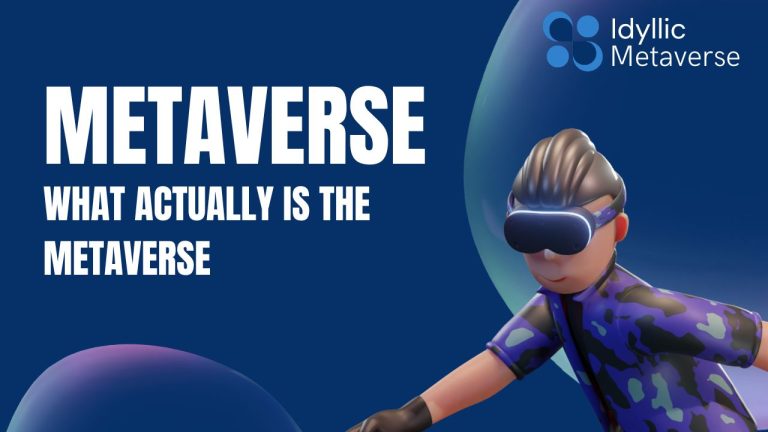Related Metaverse Technology
What Is Metaverse Technology?
The Metaverse is simply a post-reality cosmos that combines actual reality with digital virtual worlds in a continuous, endless shared world.
It’s a good idea to have a backup plan in case the backup fails. As a result, the Metaverse Technology is a persistent network of realistic and social fully distributed platforms.
How Does the Metaverse Technology Work?
The game designer, author, and businessman Jon Radoff provided a 7-tiered conceptual framework to describe the Metaverse economy’s value chain.
According to the theory, the Metaverse Technology is divided into seven layers: infrastructure, experience, discovery, creator economies, spatial computing, decentralization, and human interference.
The 7 Layers Of Metaverse Technology
The Metaverse, according to novelist, game developer, and businessman Jon Radoff, is split into seven different layers, each of which affects a different aspect of the user experience. Let’s look at each of them individually:
Experience:
The Metaverse Technology will give us access to a variety of 2D (two-dimensional) and 3D (three-dimensional) images that we are unable to currently appreciate.
Discovery:
There are still inbound and outbound discovery techniques in the Metaverse Technology ecosystem. Inbound discovery describes when people look for knowledge on purpose. On the other side, outbound marketing refers to sending communications to people whether or not they asked for it.
Decentralization:
By utilizing a scalable ecosystem supported by microservices and distributed computing, developers can benefit from online capabilities. Additionally, blockchain technology and smart contracts provide manufacturers access to their information and products.
Human Interface:
With a combination of human interface and spatial computing, users may access maps, learn about their surroundings, and even create shared AR experiences by simply gazing at them in the real world.
Infrastructure:
The technological infrastructure is necessary for the use of additional layers. To increase network capacity and reduce network congestion, it uses 5G and 6G computing.
Metaverse Solutions
Hardware
People who are new to the realm of Metaverse Technology are frequently ignorant of the bare essentials necessary to experience it. You will want some fundamental devices or tools from your arsenal to explore this brave new virtual world. The better your experience will be, the more hardware you invest in. Why? Because of how popular the Metaverse is as a visual medium.
Important Hardware
You can access Metaverse platforms with your smartphone. If you want to utilize technology to its fullest, you must step it up. It’s worth changing your gadget, especially if it’s more than two years old if this is a topic you wish to research further. But, many AR apps require a smartphone or tablet to work at the beginning level. Older gadgets will still work, but newer ones will perform better.
Experiences in Two Dimensions
It is very necessary to have a powerful laptop or desktop computer with a capable graphics card (minimum 4G), a quick processor (at least 3.5GHz for a CPU), and a strong internet connection. With this setting, you can participate in Metaverse without experiencing any lag.
If you don’t have a solid setup, everything will be agonizingly slow while several users are completing various things at once. Think of the Metaverse as a highly developed gaming environment. This is your best choice because it has already been tuned if you are an expert with gaming PCs and want to invest money in a rig.
The medium that connects 2D and total immersion is audio. A set of noise-canceling headphones with an in-line microphone, such as the Apple AirPods, adds another level of realism. They enable you to experience the Metaverse Technology fully without having to spend money on virtual reality goggles.
When Fully Immersed
With the ability to fully immerse users in Metaverse Technology platforms, Full Immersion VR headsets are currently the top tier of Metaverse equipment. With WiFi capabilities, the best platforms, like the Meta Quest, let you access the Metaverse from any location with an internet connection.
Another thing to think about is the graphics. Not all VR headsets are created equal, therefore it’s essential to pick one with a good resolution if you want to enjoy the quality of the experience.
Software
Although the metaverse exists now, it was only made possible by particular technologies. We will present numerous state-of-the-art technologies that enable the Metaverse Technology. What they are are these:
Blockchain and digital money
Blockchain technology, on the other hand, offers decentralized and transparent digital evidence of ownership, value transfer, collectibility, governance, and accessibility. People can exchange value using cryptocurrencies while working and interacting in the 3D virtual world.
For instance, digital lands in Decentraland may be purchased using cryptocurrency. Also, players can buy 16×16 meter land parcels in NFT (non-fungible token) form using the game’s MANA cryptocurrency.
Crypto may inspire people to labor in the metaverse in the future. We might see job postings for positions relating to the metaverse as more businesses move their offices online for remote workers.
Virtual reality and augmented reality
We can have a compelling and pleasurable 3D experience with AR and VR. We now join the virtual world at this point. But how do augmented reality and virtual reality differ from one another?
Augmented reality (AR) modifies the natural environment by including digital characters and visual components. It works with any smartphone or digital device that includes a built-in camera and is less frightful than Virtual Reality. AR-enabled games, like the mobile game Pokémon, GO, let players use dynamic digital graphics to gaze around them. Gamers can capture Pokémon both virtually and in the real world by unlocking the cameras on their phones.
VR operates distinctively. It creates a virtual environment created by computers that is similar to the idea of the metaverse. Virtual reality headsets, sensors, and gloves can all be used to explore it.
The way that Augmented Reality and Virtual Reality work is one of the earliest examples of the metaverse. By the use of synthetic visual information, virtual reality is already altering the digital environment. The metaverse experience may be expanded to incorporate physical simulations that employ VR technology as the field of virtual reality advances. People from all around the world will be able to sense, hear, and speak with users. More metaverse corporations may soon invest in developing AR and VR technology, given the excitement surrounding the metaverse.
Reconstruction in 3D
Although this is not a new technology, its use has increased throughout the epidemic, particularly in the real estate industry where lockdowns prevented prospective purchasers from physically touring properties. To provide virtual property tours, many companies have turned to 3D reconstruction technology. Buyers may explore potential new homes from a distance and make purchases without even going inside, similar to the metaverse we imagined.
One of the challenges of the metaverse is making the artificial world look as real as possible. With 3D reconstruction, it is possible to create realistic and organic-looking environments. Humans can upload their surroundings to the internet by using potent 3D cameras to produce accurate 3D photorealistic representations of buildings, actual locations, and things. The 4K HD photos and 3D spatial data are transmitted to computers, where they are processed to produce a virtual replica that users can explore in the metaverse Technology. These virtual representations of physical objects are also referred to as “digital twins”.
FAQS:
What are some instances of metaverse technology?
In this 3-D virtual world, users may make purchases, build structures, and explore NFT-based land parcels using the MANA token, which is based on Ethereum. Fortnite. The well-known online video game Epic Games offers immersive digital gameplay and a social environment in a setting that is similar to the metaverse.
AI or AR, is the metaverse?
The term “metaverse” refers to an immersive virtual environment where users can access information using VR, AR, and other technologies while being represented by personalized avatars.






